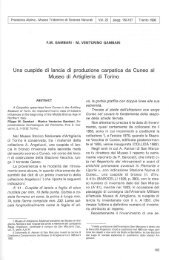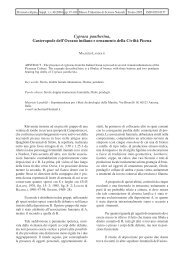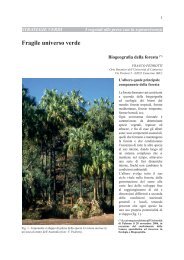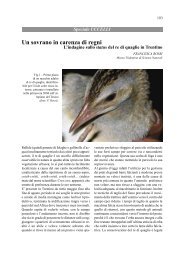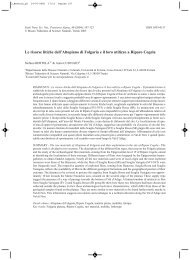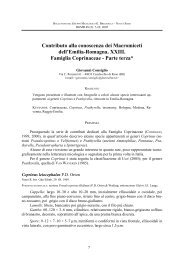Science at Museo delle Scienze - Museo Tridentino di Scienze ...
Science at Museo delle Scienze - Museo Tridentino di Scienze ...
Science at Museo delle Scienze - Museo Tridentino di Scienze ...
Create successful ePaper yourself
Turn your PDF publications into a flip-book with our unique Google optimized e-Paper software.
The main results and projects 2010-2011<br />
he<strong>at</strong> shock proteins confer thermotolerance in cold-stenothermal<br />
chironomids<br />
Section of Invertebr<strong>at</strong>e Zoology and Hydrobiology<br />
To better understand the physiological<br />
capability of cold-stenothermal organisms<br />
to survive high-temper<strong>at</strong>ures,<br />
we analyzed the thermotolerance limits<br />
and the expression level of hsp70 genes<br />
under temper<strong>at</strong>ure stress in the alpine<br />
midge Pseudo<strong>di</strong>amesa branickii (<strong>di</strong>ptera<br />
chironomidae). The resistance to he<strong>at</strong><br />
exposure is generally associ<strong>at</strong>ed with the<br />
synthesis of stress proteins, namely he<strong>at</strong><br />
shock proteins (hsPs). These are a family<br />
of highly conserved proteins th<strong>at</strong> act<br />
as chaperones to stabilize other proteins,<br />
refold partially unfolded proteins, and<br />
detect proteins th<strong>at</strong> are irreversibly damaged<br />
under stressful con<strong>di</strong>tions.<br />
A lethal temper<strong>at</strong>ure of 36°c and a<br />
lethal temper<strong>at</strong>ure 50% of 32.2°c were<br />
found for the cold stenothermal larvae<br />
after short-term shocks. The constitutive<br />
(hsc70) and inducible (hsp70) forms<br />
were both analyzed by surveying the<br />
expression of the hsp70 gene family via<br />
semi-quantit<strong>at</strong>ive reverse transcriptionpolymerase<br />
chain reaction analysis in<br />
tre<strong>at</strong>ed larvae. iV instar larvae of P. branickii<br />
showed a significant up-regul<strong>at</strong>ion<br />
of inducible hsp70 gene with increasing<br />
temper<strong>at</strong>ures and an over-expression of<br />
both hsp70 and hsc70 by increasing the<br />
time of exposure. Accor<strong>di</strong>ng to these results,<br />
we may conclude th<strong>at</strong> P. branickii<br />
was able to activ<strong>at</strong>e hsp70 genes transcription<br />
(equal to he<strong>at</strong> shock response,<br />
hsR) in response to thermal stress, <strong>di</strong>fferently<br />
from th<strong>at</strong> was shown in many<br />
cold-stenothermal Antarctic organisms in<br />
which the hsR was investig<strong>at</strong>ed.<br />
Finally, an unclear rel<strong>at</strong>ionship between<br />
hsp70 expression and survival was<br />
found, lea<strong>di</strong>ng us to surmise th<strong>at</strong> genes<br />
other than hsp70 and other processes<br />
apart from the biochemical processes<br />
might gener<strong>at</strong>e the high thermaltolerance<br />
of P. branickii larvae. These results<br />
and future high-throughput stu<strong>di</strong>es <strong>at</strong><br />
both the transcriptome and proteome<br />
level will improve our ability to pre<strong>di</strong>ct<br />
the future geographic <strong>di</strong>stribution of<br />
this species within the context of global<br />
warming.<br />
Bernabò P., Martinez Guitarte J.l., Rebecchi<br />
l., Jousson o. & lencioni V., 2011 - Thermotolerance<br />
and hsp70 he<strong>at</strong> shock response<br />
in the cold-stenothermal chironomid Pseudo<strong>di</strong>amesa<br />
branickii (ne italy). Cell Stress and<br />
Chaperones, 16 (4): 403-410.<br />
Rel<strong>at</strong>ive expression r<strong>at</strong>io (2-log scale) of the<br />
hsp70 (gray bars) and hsc70 (white bars) after<br />
1, 2, and 4 h of shock and after 1 h of preexposition<br />
followed by 1 h <strong>at</strong> 4°c and by 1 h<br />
of shock (P +1h) <strong>at</strong> 26°c and 32°c. Asterisk,<br />
significant <strong>di</strong>fferences (p≤0.05) of the level<br />
of expression after short-term stress (1 h)<br />
rel<strong>at</strong>ive to the level of control larvae; empty<br />
circle, significant <strong>di</strong>fferences (p≤0.05) of the<br />
level of expression after long-term stress (2<br />
and 4 h) rel<strong>at</strong>ive to level of larvae stressed<br />
for 1 h; number sign, significant <strong>di</strong>fferences<br />
(p≤0.05) of the level of expression after<br />
shock (1 h) with pre-exposition rel<strong>at</strong>ive to the<br />
larvae stressed without pre-exposition (1 h).<br />
33<br />
1R<br />
2R 2r<br />
3R<br />
4R<br />
5R<br />
6R



